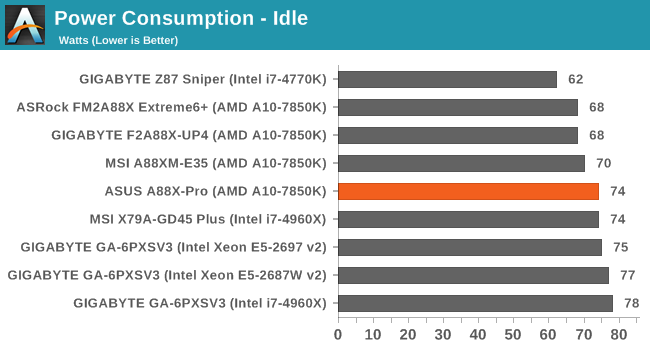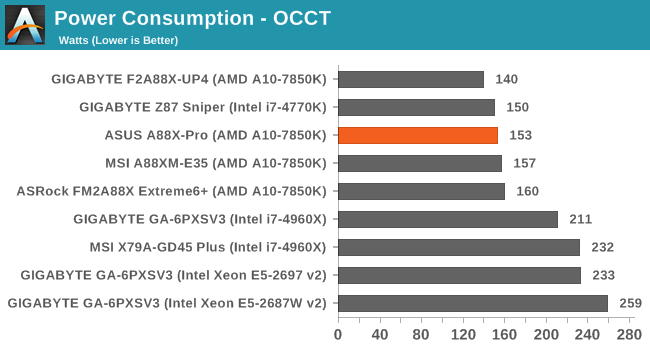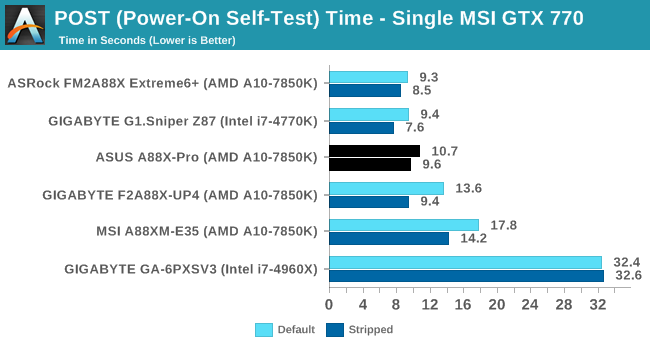ASUS A88X-Pro Review: Kaveri, Kaveri, Quite Contrary
by Ian Cutress on April 22, 2014 11:59 AM EST- Posted in
- Motherboards
- AMD
- Asus
- Kaveri
Many thanks to...
We must thank the following companies for kindly providing hardware for our test bed:
Thank you to OCZ for providing us with 1250W Gold Power Supplies and SSDs.
Thank you to G.Skill and ADATA for providing us with memory kits.
Thank you to Corsair for providing us with an AX1200i PSU, Corsair H80i CLC and 16GB 2400C10 memory.
Thank you to ASUS for providing us with the AMD HD7970 GPUs and some IO Testing kit.
Thank you to MSI for providing us with the NVIDIA GTX 770 Lightning GPUs.
Thank you to Rosewill for providing us with the 500W Platinum Power Supply for mITX testing, BlackHawk Ultra, and 1600W Hercules PSU for extreme dual CPU + quad GPU testing, and RK-9100 keyboards.
Thank you to ASRock for providing us with the 802.11ac wireless router for testing.
Test Setup
| Test Setup | |
| Processor |
AMD A10-7850K (ES) 2 Modules, 4 Threads |
| Motherboards | ASUS A88X-Pro |
| Cooling |
Corsair H80i Thermalright TRUE Copper |
| Power Supply |
OCZ 1250W Gold ZX Series Corsair AX1200i Platinum PSU |
| Memory |
AMD Gaming 2x8GB DDR3-2133 10-11-11 Kit 2 x Corsair Vengeance Pro 2x8 GB DDR3-2400 10-12-12 Kit |
| Memory Settings | XMP |
| Video Cards |
MSI GTX 770 Lightning 2GB (1150/1202 Boost) ASUS HD7970 3GB (Reference) |
| Video Drivers |
Catalyst 13.12 NVIDIA Drivers 332.21 |
| Hard Drive | OCZ Vertex 3 256GB |
| Optical Drive | LG GH22NS50 |
| Case | Open Test Bed |
| Operating System | Windows 7 64-bit SP1 |
| USB 2/3 Testing | OCZ Vertex 3 240GB with SATA->USB Adaptor |
| WiFi Testing | D-Link DIR-865L 802.11ac Dual Band Router |
Power Consumption
Power consumption was tested on the system as a whole with a wall meter connected to the OCZ 1250W power supply, while in a single MSI GTX 770 Lightning GPU configuration. This power supply is Gold rated, and as I am in the UK on a 230-240 V supply, leads to ~75% efficiency > 50W, and 90%+ efficiency at 250W, which is suitable for both idle and multi-GPU loading. This method of power reading allows us to compare the power management of the UEFI and the board to supply components with power under load, and includes typical PSU losses due to efficiency. These are the real world values that consumers may expect from a typical system (minus the monitor) using this motherboard.
While this method for power measurement may not be ideal, and you feel these numbers are not representative due to the high wattage power supply being used (we use the same PSU to remain consistent over a series of reviews, and the fact that some boards on our test bed get tested with three or four high powered GPUs), the important point to take away is the relationship between the numbers. These boards are all under the same conditions, and thus the differences between them should be easy to spot.



Power consumption on the A88X-Pro is in line with other motherboards, however the IR355x ICs of the GIGABYTE seem to have the advantage during high CPU loading.
Windows 7 POST Time
Different motherboards have different POST sequences before an operating system is initialized. A lot of this is dependent on the board itself, and POST boot time is determined by the controllers on board (and the sequence of how those extras are organized). As part of our testing, we are now going to look at the POST Boot Time - this is the time from pressing the ON button on the computer to when Windows 7 starts loading. (We discount Windows loading as it is highly variable given Windows specific features.) These results are subject to human error, so please allow +/- 1 second in these results.

With the focus on fast booting into Windows 8, there is little incentive to optimize the POST sequence for other OSes. Nevertheless we see that a good ~1/3 of ASUS’ boot time can be saved by disabling unwanted controllers.










34 Comments
View All Comments
Ortanon - Tuesday, April 22, 2014 - link
EXACTLY. I've been scratching my head on this one. The only possible argument would be that you can cram more gaming into a smaller case, but that's an idiotic argument because 1) who the hell is so desperate to fit a system down to the millimeter and 2) the real-life difference between mini-ITX and micro-ATX cases is often one or two inches in any given dimension.So ultimately Kaveri is, unfortunately, a bust. A moot point. A waste of precious R&D resources. And it's such a shame.
On the bright side, all they'd have to do is adjust the price point. A lot.
Topweasel - Tuesday, April 22, 2014 - link
Obviously you haven't tried to build a computer in SG05 or Ncase M1. Not every ITX case is Prodigy or 250D. Most are much much much smaller in all dimensions than most mATX cases. I would say it's more of the ATX vs mATX that's always bothered me. More often than not an mATX case isn't much smaller than a well spaced full ATX mid tower.That said this motherboard is about as useless as one could be. I see why they are doing it. They want full sized full featured ATX boards for the AMD platform, but with AMD almost completely shutting down AM3+ developments, the future of AMD's platforms is in the FM2 and up. Spending 200$ on a full ATX system just to use integrated video doesn't make sense. I guess one could say there is more performance and power savings when tied to discrete AMD GPU. But APU's are at their best when they are the sole source of video. Certainly not worth spending i5 money otherwise. Which is why it would work best in an ITX setup where both space and cooling are enough of a issue that one would rather do without a discrete card if possible.
PEJUman - Tuesday, April 22, 2014 - link
^^ ThisI was able to purchase the 7850K for 120 at local microcenter and a Asrock A88X-ITX+ for 100 at newegg. At $220 combined price, Kaveri is very hard to pass up. yes, you can get cheaper systems, but it's price/performance/size/power ratio is unique. This is no longer the case if you approach $300. They really need to drop the price down to around 100 for the CPU.
just4U - Tuesday, April 22, 2014 - link
I'd have to agree with that.. Which is why I am waiting on the A8s Their supposed to be priced in and around 90-120 which is somewhat of a sweet spot. As we move up to the 150-180 dollar A10s that drops off a little as you could always pair a discrete card (say a GDR5 240 or something) and blow it all out of the water.BinaryTB - Tuesday, April 22, 2014 - link
HTPCs. Lower heat, lower noise, lower power consumption.CPU and graphics don't matter much if you can decode high bitrate video in hardware and put it all in a small package.
The same argument could be used for laptops as well.
But I do agree with you, if you have a desktop and want performance, separates is the way to go.
eanazag - Tuesday, April 22, 2014 - link
Power consumption and heat are the difference. I do agree with just4U that I really just wanted the A8-7600. With the price about a $100 it makes more sense to me. I think the OEMs cried for it so we got shafted in channel.abufrejoval - Tuesday, April 22, 2014 - link
I'm guessing as to what you'd want: A <95Watt TDP APU, which still has the biggest GPU AMD can make... I think you're willing to sacrifice CPU clock for low TDP, but not graphics performance and would like to hit the 65 or 45 Watt "sweet spots", right?Well you don't need to actually wait for anything: These APUs are all one single die anyway, including all the mobile variants (once they come).
And, at least on Asus, you have the ability to configure your desired TDP in the BIOS, at least between 40 (could be 45) and 65 Watts.
Here is what happens:
You leave that setting alone, you'll get a 95Watts part, which means 3.7 GHz base, while it will clock to 4.0GHz as long as the thermal budget lasts.
You set it to any number between 65 and 40/45 and you'll get exactly that: An APU which will fiddle with GPU and CPU budgets until they meet your TDP limit.
You use single threaded CPU load at 45Watts TDP, you may well get 4.0 GHz for quite a while.
You use tons of GPU, your CPU may well slow to the 1 GHz range (actually I believe it won't drop below 1.6GHz).
So with previous generation APUs like Trinity and Richmond the TDP settings were hard-wired into the die before packaging and sale. With Kaveri, from what I am seeing, there is really just two variants: One with 512 graphic cores enabled and one with 384 graphic cores enabled. Everything else is configuration done completely in software, which is just perfect from where I stand ;-)
I can buy a Kaveri today and push it to its absolute limits with heavy overclock on a "Pro" mainboard and I can transfer it into a mini-ITX board tomorrow and tell it to never use beyond 45Watts and it will just do as it was told!
Completely anti-market-segmentation and just the way I like it as a *consumer*.
pidgin - Tuesday, April 22, 2014 - link
I really regret going with ASRock FM2A88X Killer+, nothing but memory problems, basically no driver updates on driver page, ughhtuklap - Friday, April 25, 2014 - link
seems that you have to take it unto asrock.. I was targetting ASRock FM2A88X Killer+ too but when I read some problems and noticed that there are no driver updates i switched my eye to asrock fm2+ extreme6+ ^_^ never had problems.. although I wish they have esd protections and anti-surge ic's placed on the board. also they should have made it sturdier.all in all quite happy.
this board is solid. but the thing here is it lacks on board switches for power and reset
tech6 - Tuesday, April 22, 2014 - link
I'm sure this is a great boar but none of this matters until AMD release a CPU that is power consumption and performance competitive with what Intel is currently offering. The AMD on board graphics are great but the rest of the CPU and the power consumption are currently simply not competitive.